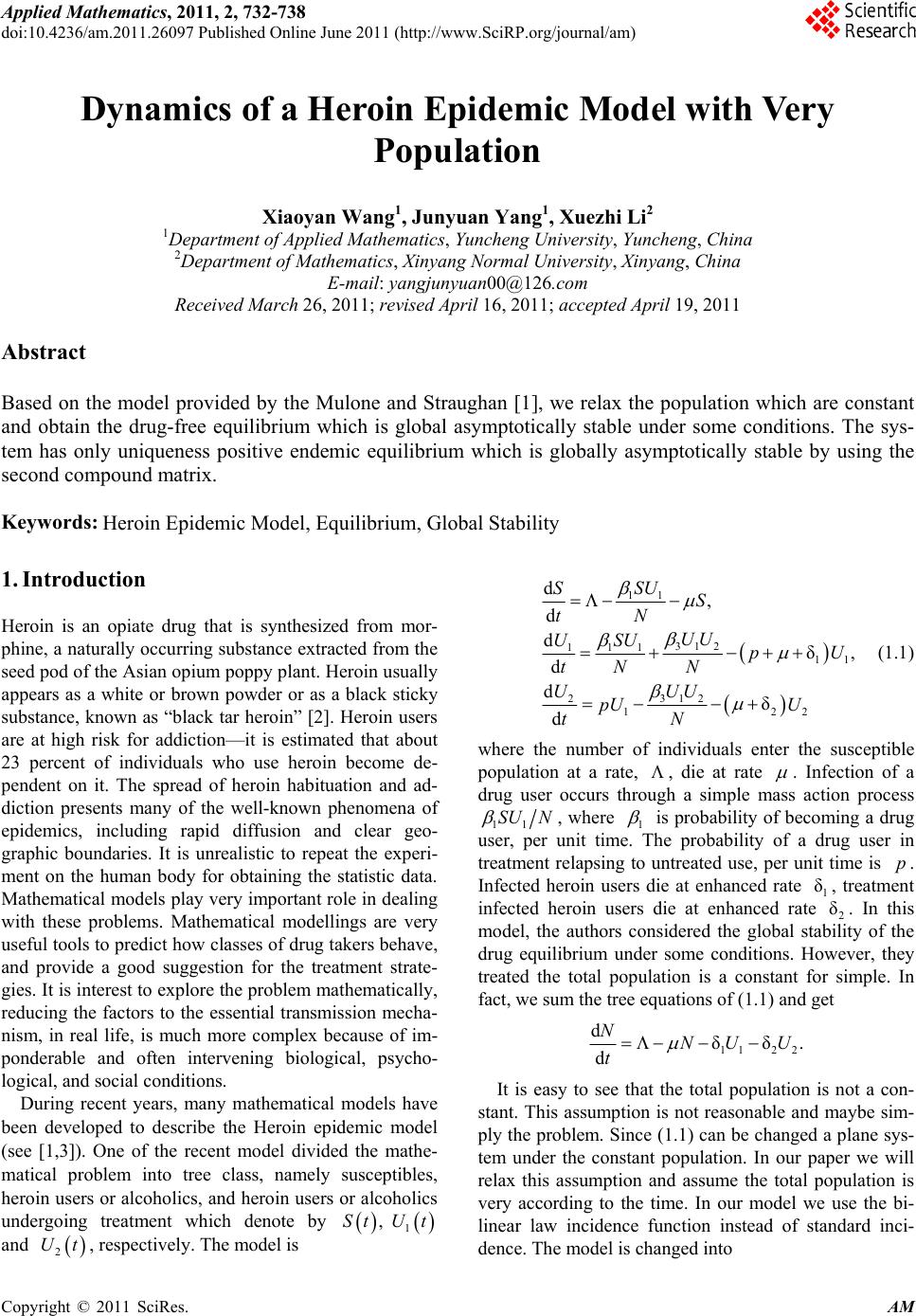 Applied Mathematics, 2011, 2, 732-738 doi:10.4236/am.2011.26097 Published Online June 2011 (http://www.SciRP.org/journal/am) Copyright © 2011 SciRes. AM Dynamics of a Heroin Epidemic Model with Very Population Xiaoyan Wang1, Junyuan Yang1, Xuezhi Li2 1Department of Applied Mathematics, Yuncheng University, Yuncheng, China 2Department of Mat hem at i cs, Xinyang Normal University, Xinyang, China E-mail: yangjunyuan00@126.com Received March 26, 2011; revised April 16, 2011; accepted April 19, 2011 Abstract Based on the model provided by the Mulone and Straughan [1], we relax the population which are constant and obtain the drug-free equilibrium which is global asymptotically stable under some conditions. The sys- tem has only uniqueness positive endemic equilibrium which is globally asymptotically stable by using the second compound matrix. Keywords: Heroin Epidemic Model, Equilibrium, Global Stability 1. Introduction Heroin is an opiate drug that is synthesized from mor- phine, a naturally occurring substance extracted from the seed pod of the Asian opium poppy plant. Heroin usually appears as a white or brown powder or as a black sticky substance, known as “black tar heroin” [2]. Heroin users are at high risk for addiction—it is estimated that about 23 percent of individuals who use heroin become de- pendent on it. The spread of heroin habituation and ad- diction presents many of the well-known phenomena of epidemics, including rapid diffusion and clear geo- graphic boundaries. It is unrealistic to repeat the experi- ment on the human body for obtaining the statistic data. Mathematical models play very important role in dealing with these problems. Mathematical modellings are very useful tools to predict how classes of drug takers behave, and provide a good suggestion for the treatment strate- gies. It is interest to explore the problem mathematically, reducing the factors to the essential transmission mecha- nism, in real life, is much more complex because of im- ponderable and often intervening biological, psycho- logical, and social conditions. During recent years, many mathematical models have been developed to describe the Heroin epidemic model (see [1,3]). One of the recent model divided the mathe- matical problem into tree class, namely susceptibles, heroin users or alcoholics, and heroin users or alcoholics undergoing treatment which denote by 1 , StU t and , respectively. The model is 2 Ut 11 312 111 11 312 2 12 d, d dδ, d dδ d SU SS tN UU USU p tN N UU UpU U tN 2 U (1.1) where the number of individuals enter the susceptible population at a rate, , die at rate . Infection of a drug user occurs through a simple mass action process 11 SU N , where 1 is probability of becoming a drug user, per unit time. The probability of a drug user in treatment relapsing to untreated use, per unit time is . Infected heroin users die at enhanced rate 1, treatment infected heroin users die at enhanced rate 2. In this model, the authors considered the global stability of the drug equilibrium under some conditions. However, they treated the total population is a constant for simple. In fact, we sum the tree equations of (1.1) and get p δ δ 112 2 dδδ. d NNU U t It is easy to see that the total population is not a con- stant. This assumption is not reasonable and maybe sim- ply the problem. Since (1.1) can be changed a plane sys- tem under the constant population. In our paper we will relax this assumption and assume the total population is very according to the time. In our model we use the bi- linear law incidence function instead of standard inci- dence. The model is changed into 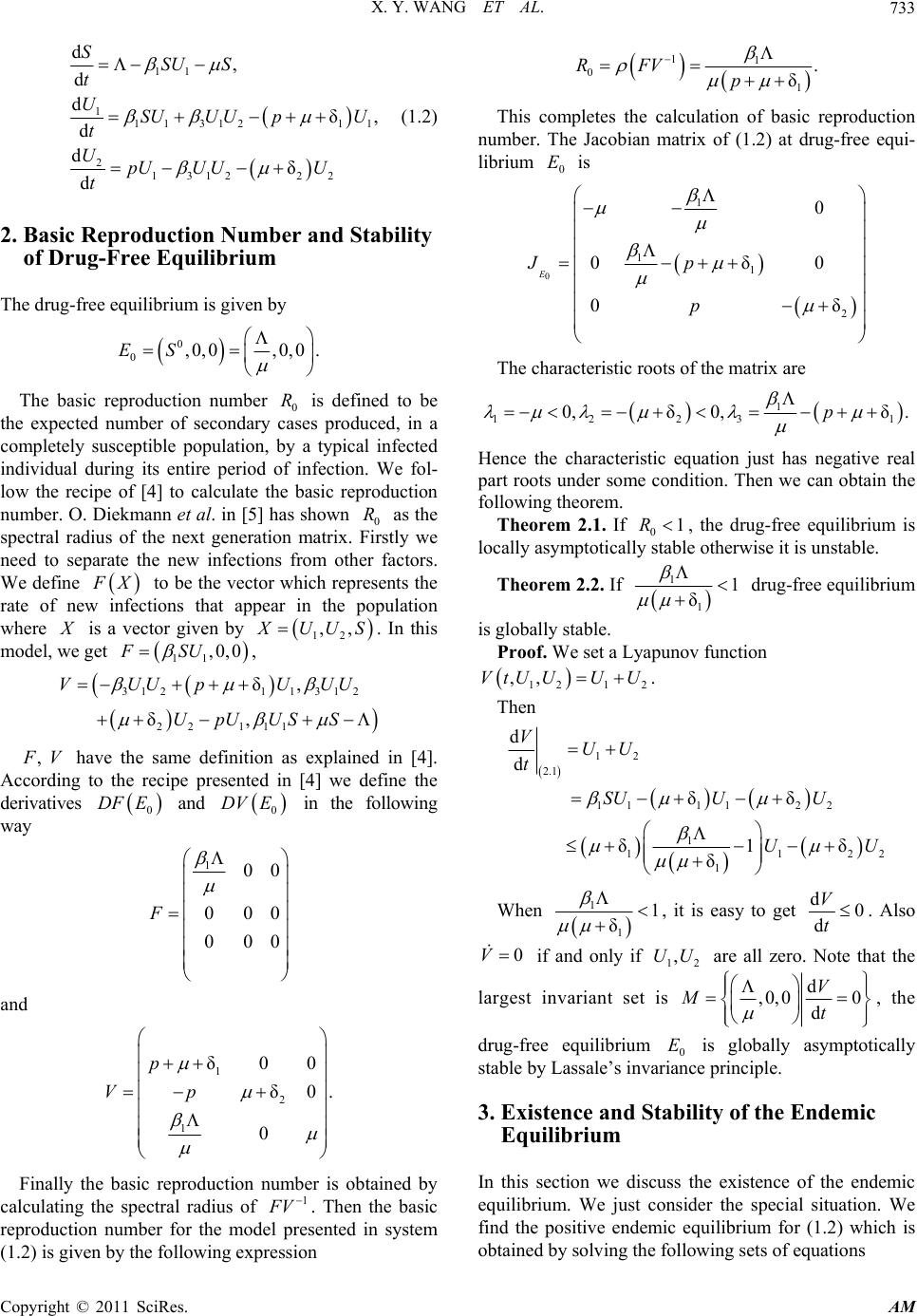 X. Y. WANG ET AL.733 11 1 11 31211 2 1312 22 d, d dδ, d dδ d SSU S t USUU UpU t UpUUUU t (1.2) 2. Basic Reproduction Number and Stability of Drug-Free Equilibrium The drug-free equilibrium is given by 0 0,0,0,0,0.ES The basic reproduction number 0 is defined to be the expected number of secondary cases produced, in a completely susceptible population, by a typical infected individual during its entire period of infection. We fol- low the recipe of [4] to calculate the basic reproduction number. O. Diekmann et al. in [5] has shown 0 as the spectral radius of the next generation matrix. Firstly we need to separate the new infections from other factors. We define R R X to be the vector which represents the rate of new infections that appear in the population where is a vector given by 12 ,, UU S. In this model, we get , 11 ,0,0FSU 31211 312 22 111 δ, δ, VUUp UUU UpUUSS , V have the same definition as explained in [4]. According to the recipe presented in [4] we define the derivatives and in the following way 0 DF E 0 DV E 100 000 000 F and 1 2 1 δ00 δ0. 0 p Vp Finally the basic reproduction number is obtained by calculating the spectral radius of 1 V. Then the basic reproduction number for the model presented in system (1.2) is given by the following expression 11 0 1 . δ RFV p This completes the calculation of basic reproduction number. The Jacobian matrix of (1.2) at drug-free equi- librium is 0 E 0 1 1 1 2 0 0δ0 0δ E Jp p The characteristic roots of the matrix are 1 1223 0, δ0, δ.p 1 Hence the characteristic equation just has negative real part roots under some condition. Then we can obtain the following theorem. Theorem 2.1. If 01R , the drug-free equilibrium is locally asymptotically stable otherwise it is unstable. Theorem 2.2. If 1 1 1 δ drug-free equilibrium is globally stable. Proof. We set a Lyapunov function 121 2 ,,VtUUU U . Then 12 21 11112 2 1 11 1 d d δδ δ1δ δ VUU t SU UU UU 22 When 1 1 1 δ , it is easy to get d0 d V t . Also 0V if and only if are all zero. Note that the 12 ,UU largest invariant set is d ,0,0 0 d V Mt , the drug-free equilibrium 0 is globally asymptotically stable by Lassale’s invariance principle. E 3. Existence and Stability of the Endemic Equilibrium In this section we discuss the existence of the endemic equilibrium. We just consider the special situation. We find the positive endemic equilibrium for (1.2) which is obtained by solving the following sets of equations Copyright © 2011 SciRes. AM 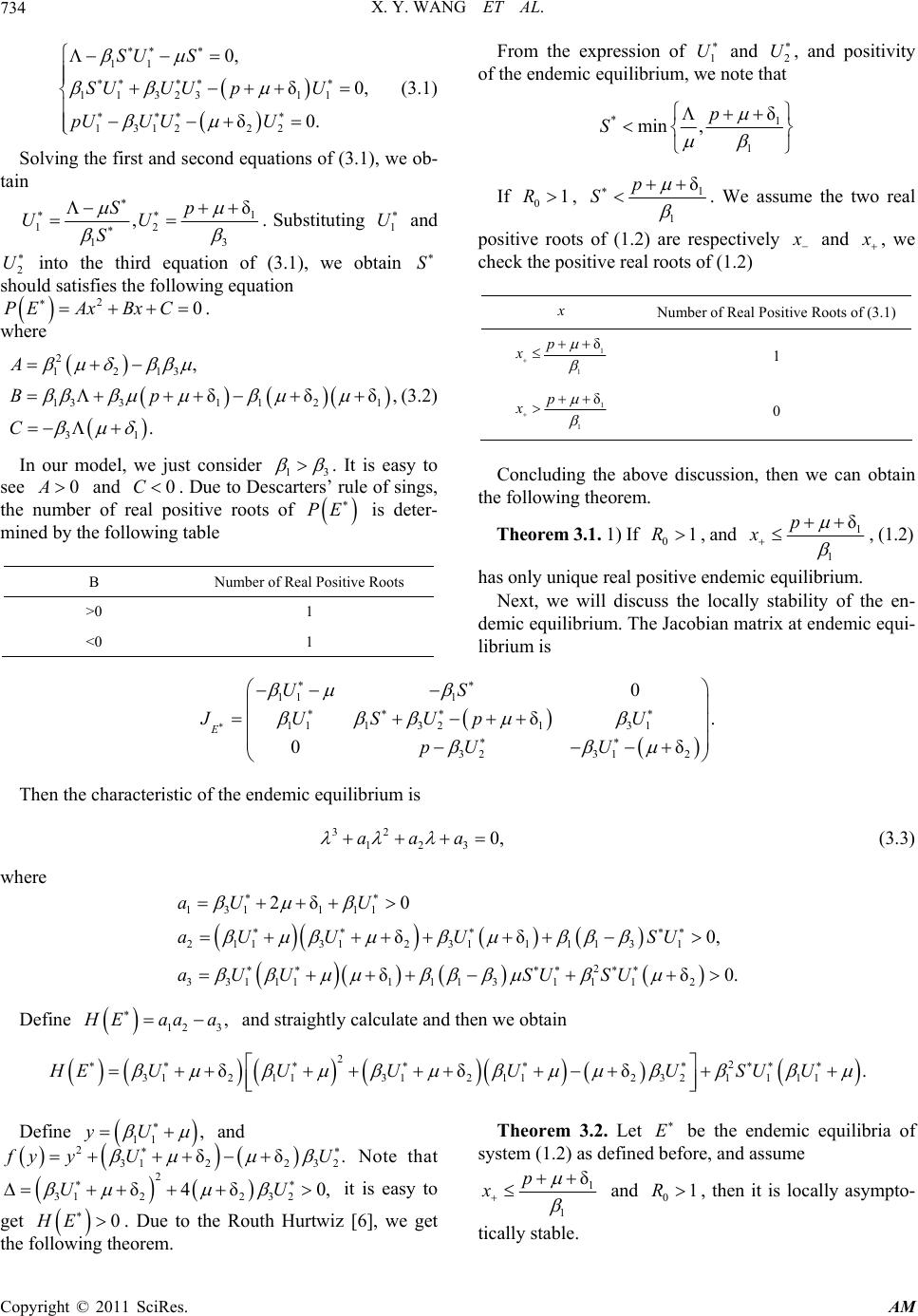 X. Y. WANG ET AL. Copyright © 2011 SciRes. AM 734 From the expression of 1 and 2 U, and positivity of the endemic equilibrium, we note that U 11 11 32311 1312 22 0, δ0, δ0. SU S SUUU pU pUU UU (3.1) *1 1 δ min, p S Solving the first and second equations of (3.1), we ob- tain If , 01R1 1 δp S . We assume the two real 1 12 3 1 δ ,p S UU S . Substituting 1 U and positive roots of (1.2) are respectively and , we check the positive real roots of (1.2) 2 into the third equation of (3.1), we obtain US should satisfies the following equation . 20AxBx C P E Number of Real Positive Roots of (3.1) 1 1 δp x 1 1 1 δp x 0 where 2 1213 1331 121 31 , δδ, . A Bp C δ (3.2) In our model, we just consider 13 PE . It is easy to see and . Due to Descarters’ rule of sings, the number of real positive roots of is deter- 0A0C Concluding the above discussion, then we can obtain the following theorem. Theorem 3.1. 1) If , and 01R1 1 δp x , (1.2) mined by the following table B Number of Real Positive Roots >0 1 <0 1 has only unique real positive endemic equilibrium. Next, we will discuss the locally stability of the en- demic equilibrium. The Jacobian matrix at endemic equi- librium is 11 1 1113 2131 32312 0 δ. 0δ E US JUSUp U pU U Then the characteristic of the endemic equilibrium is 32 123 0,aaa (3.3) where 131 111 211312311113 1 2 33111111311 12 2δ0 δδ 0, δδ0. aU U aU UUSU aUUSU SU Define 12 3 , Eaaa and straightly calculate and then we obtain 22 31 21131 2112321111 δδδ .HEUUUUUSUU Define 11 ,yU and 31 22 32 δδ. 2 yy U 2 Theorem 3.2. Let E be the endemic equilibria of system (1.2) as defined before, and assume U Note that 31 2232 δ4δ0,UU it is easy to 1 1 δp x and , then it is locally asympto- 01R get . Due to the Routh Hurtwiz [6], we get the following theorem. 0HEtically stable. 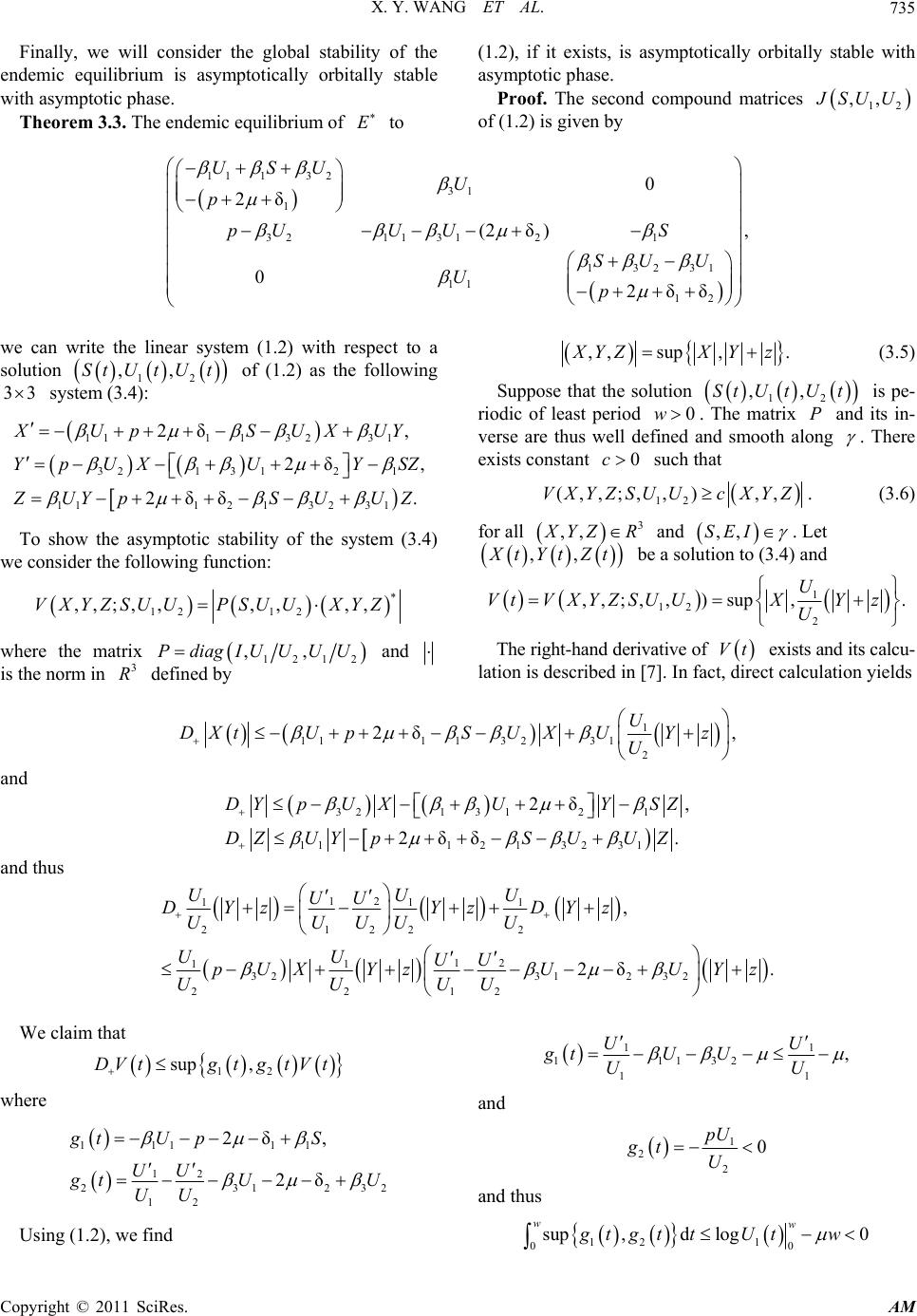 X. Y. WANG ET AL.735 Finally, we will consider the global stability of the endemic equilibrium is asymptotically orbitally stable with asymptotic phase. Theorem 3.3. The endemic equilibrium of E to (1.2), if it exists, is asymptotically orbitally stable with asymptotic phase. Proof. The second compound matrices 12 ,, SU U of (1.2) is given by 1113 2 31 1 3211 3121 13231 11 12 0 2δ (2 δ), 02δδ USU U p pUU US SU U Up we can write the linear system (1.2) with respect to a solution of (1.2) as the following system (3.4): 12 ,,St U t Ut 33 11113 231 3213 121 111213 231 2δ, 2δ, 2δδ . UpSUXUY YpUXU YSZ UYpSUUZ To show the asymptotic stability of the system (3.4) we consider the following function: 12 12 ,,;, ,, ,,,V XYZSUUPSUUXYZ where the matrix 1212 ,,P diagIUUUU and is the norm in defined by 3 R ,,sup ,. YZXYz (3.5) Suppose that the solution 12 ,,St U t Ut P is pe- riodic of least period . The matrix and its in- verse are thus well defined and smooth along 0w . There exists constant such that 0c 12 (,,;, ,),,VXYZSUUc XYZ. (3.6) for all 3 ,, YZ R and ,,SEI . Let ,, tYtZt be a solution to (3.4) and 1 12 2 ,,;,,) sup,. U Vt VXYZSUUXY z U The right-hand derivative of Vt exists and its calcu- lation is described in [7]. In fact, direct calculation yields 1 11113 231 2 2δ, U DXtUpSU XUYz U and 3213121 111213 231 2δ, 2δδ . DYpUXUYSZ DZUYpSUU Z and thus 12 111 21222 12 11 32312 32 2212 , 2δ. UUU UU DYzYz DYz UUUUU UU UU pUXYzUUYz UUUU We claim that 12 sup ,DV tgtgtV t where 11111 12 231 12 2δ 2δ gtU pS UU 232 tU UU U Using (1.2), we find 11 11132 11 , UU gtU U UU and 1 2 2 0 pU gt U and thus 12 1 0 0sup,d log0 ww gtgttUtw Copyright © 2011 SciRes. AM 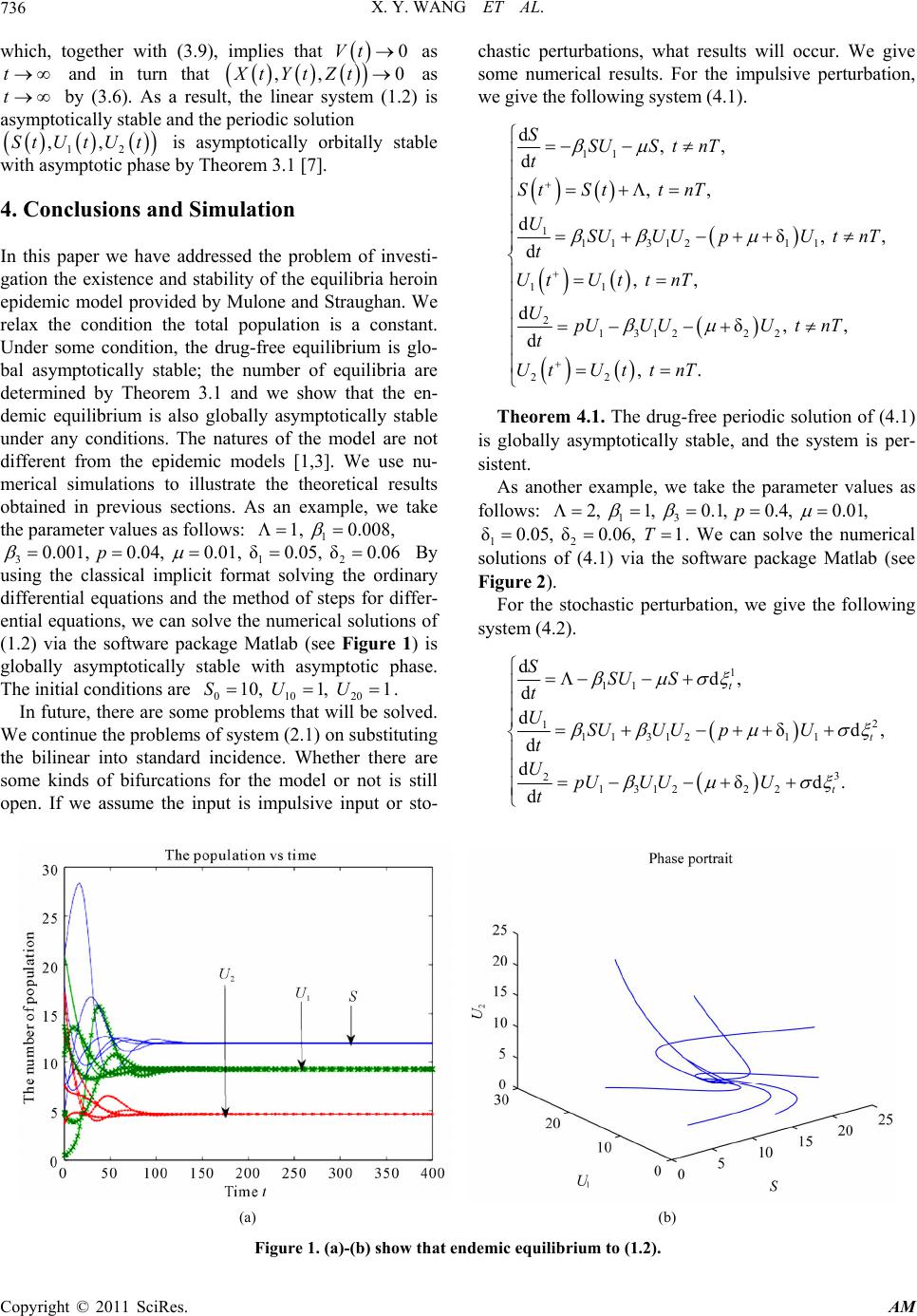 X. Y. WANG ET AL. 736 which, together with (3.9), implies that as and in turn that 0Vt t Zt,,Xt Yt 0 as by (3.6). As a result, the linear system (1.2) is asymptotically stable and the periodic solution 12 is asymptotically orbitally stable with asymptotic phase by Theorem 3.1 [7]. t St ,,UtUt 4. Conclusions and Simulation In this paper we have addressed the problem of investi- gation the existence and stability of the equilibria heroin epidemic model provided by Mulone and Straughan. We relax the condition the total population is a constant. Under some condition, the drug-free equilibrium is glo- bal asymptotically stable; the number of equilibria are determined by Theorem 3.1 and we show that the en- demic equilibrium is also globally asymptotically stable under any conditions. The natures of the model are not different from the epidemic models [1,3]. We use nu- merical simulations to illustrate the theoretical results obtained in previous sections. As an example, we take the parameter values as follows: 1 1, 0008, δ005, δ006 312 0001, 004, 001,p 10 , 1, 1SU U By using the classical implicit format solving the ordinary differential equations and the method of steps for differ- ential equations, we can solve the numerical solutions of (1.2) via the software package Matlab (see Figure 1) is globally asymptotically stable with asymptotic phase. The initial conditions are 01020 . In future, there are some problems that will be solved. We continue the problems of system (2.1) on substituting the bilinear into standard incidence. Whether there are some kinds of bifurcations for the model or not is still open. If we assume the input is impulsive input or sto- chastic perturbations, what results will occur. We give some numerical results. For the impulsive perturbation, we give the following system (4.1). 11 1 11 31211 11 2 1312 22 22 d, , d , , dδ, , d , , dδ, , d , . SSUS tnT t StStt nT USUUUpUtnT t UtUttnT UpUUUUtnT t UtUt tnT Theorem 4.1. The drug-free periodic solution of (4.1) is globally asymptotically stable, and the system is per- sistent. As another example, we take the parameter values as follows: 13 2, 1, 01, 04, 001,p T 12 δ005, δ006, 1 . We can solve the numerical solutions of (4.1) via the software package Matlab (see Figure 2). For the stochastic perturbation, we give the following system (4.2). 1 11 2 1 11 31211 3 2 1312 22 dd, d dδd, d dδd. d t t t SSU S t USUUUpU t UpUUUU t (a) (b) Figure 1. (a)-(b) show that endemic equilibrium to (1.2). Copyright © 2011 SciRes. AM 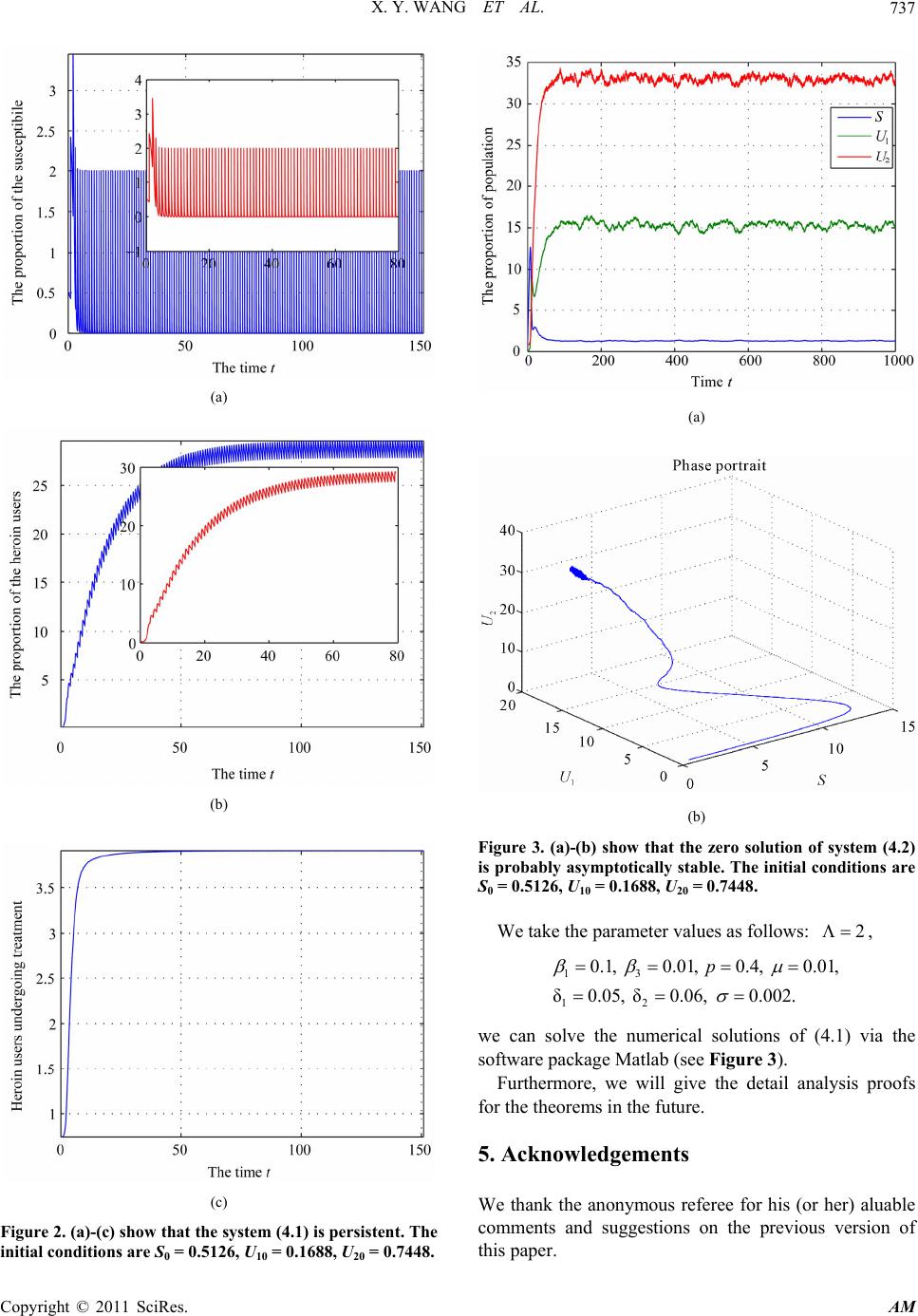 X. Y. WANG ET AL. Copyright © 2011 SciRes. AM 737 (a) (b) (c) Figure 2. (a)-(c) show that the system (4.1) is persistent. The initial conditions are S0 = 0.5126, U10 = 0.1688, U20 = 0.7448. (a) (b) Figure 3. (a)-(b) show that the zero solution of system (4.2) is probably asymptotically stable. The initial conditions are S0 = 0.5126, U10 = 0.1688, U20 = 0.7448. We take the parameter values as follows: , 2 13 12 01, 001, 04, 001, δ005, δ006, 0002. p we can solve the numerical solutions of (4.1) via the software package Matlab (see Figure 3). Furthermore, we will give the detail analysis proofs for the theorems in the future. 5. Acknowledgements We thank the anonymous referee for his (or her) aluable comments and suggestions on the previous version of this paper. 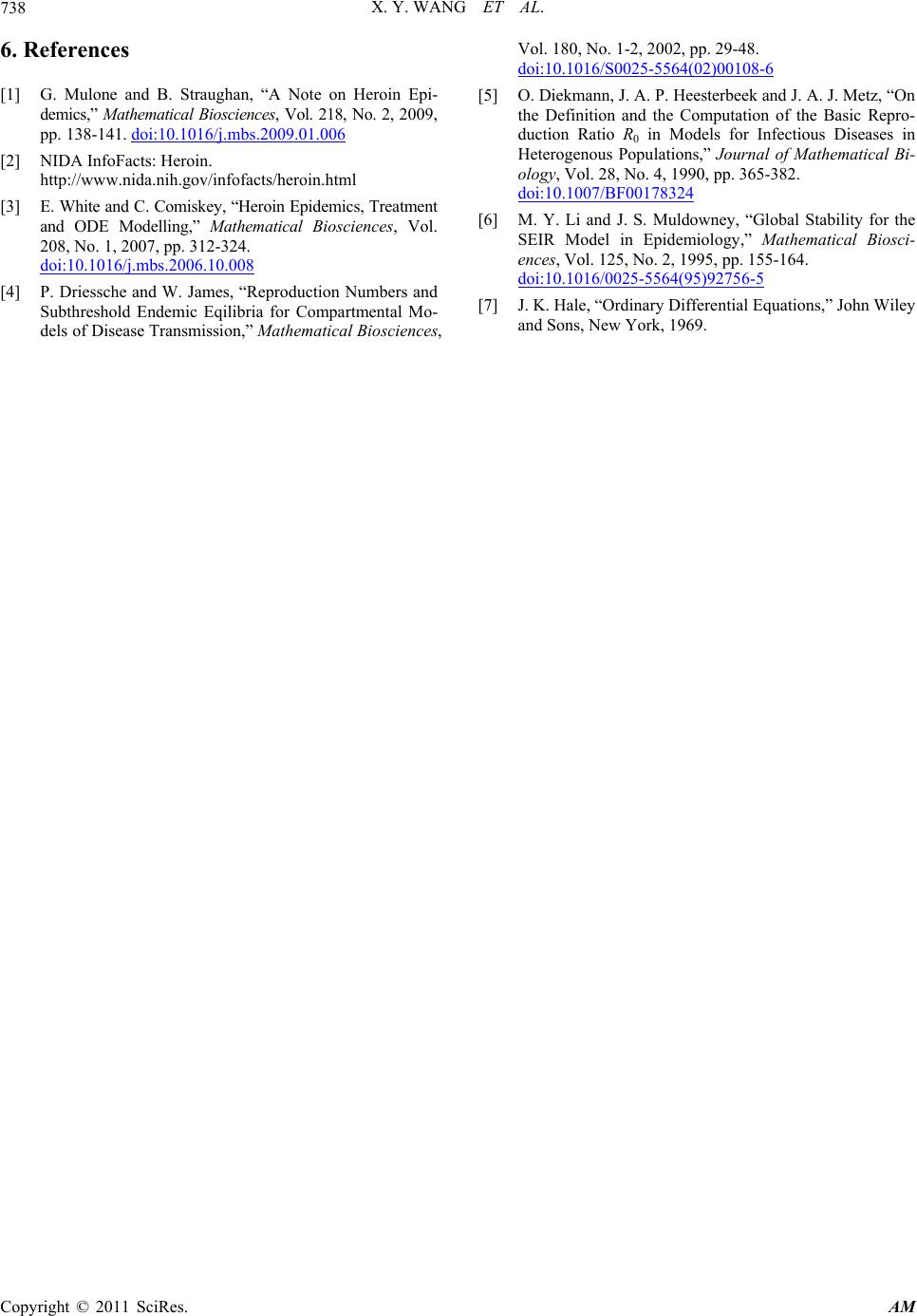 X. Y. WANG ET AL. 738 6. References [1] G. Mulone and B. Straughan, “A Note on Heroin Epi- demics,” Mathematical Biosciences, Vol. 218, No. 2, 2009, pp. 138-141. doi:10.1016/j.mbs.2009.01.006 [2] NIDA InfoFacts: Heroin. http://www.nida.nih.gov/infofacts/heroin.html [3] E. White and C. Comiskey, “Heroin Epidemics, Treatment and ODE Modelling,” Mathematical Biosciences, Vol. 208, No. 1, 2007, pp. 312-324. doi:10.1016/j.mbs.2006.10.008 [4] P. Driessche and W. James, “Reproduction Numbers and Subthreshold Endemic Eqilibria for Compartmental Mo- dels of Disease Transmission,” Mathematical Biosciences, Vol. 180, No. 1-2, 2002, pp. 29-48. doi:10.1016/S0025-5564(02)00108-6 [5] O. Diekmann, J. A. P. Heesterbeek and J. A. J. Metz, “On the Definition and the Computation of the Basic Repro- duction Ratio R0 in Models for Infectious Diseases in Heterogenous Populations,” Journal of Mathematical Bi- ology, Vol. 28, No. 4, 1990, pp. 365-382. doi:10.1007/BF00178324 [6] M. Y. Li and J. S. Muldowney, “Global Stability for the SEIR Model in Epidemiology,” Mathematical Biosci- ences, Vol. 125, No. 2, 1995, pp. 155-164. doi:10.1016/0025-5564(95)92756-5 [7] J. K. Hale, “Ordinary Differential Equations,” John Wiley and Sons, New York, 1969. Copyright © 2011 SciRes. AM
|